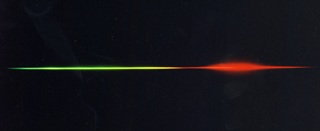Feb 20 2015
Researchers at the National Physical Laboratory (NPL) have demonstrated the highest level of agreement ever reported between two different types of femtosecond frequency combs - the tools used to measure the frequency of the next generation of atomic clocks.
 Part of a femtosecond comb spanning the spectral range from visible to mid-infrared wavelengths (500 nm to 1100 nm)
Part of a femtosecond comb spanning the spectral range from visible to mid-infrared wavelengths (500 nm to 1100 nm)
NPL's primary frequency standard is a caesium fountain atomic clock, which realises the current definition of the SI second based on the caesium atom. But optical atomic clocks currently under development, which use laser-cooled trapped ions and atoms, are capable of keeping time much more accurately than the best caesium clocks in use today. This improvement in performance means a redefinition of the second in terms of an optical frequency is expected to take place in the future.
But before that can happen, we need to be able to compare different types of optical clock against one another, to evaluate uncertainties in their measurement of time, and against our current caesium clocks, to relate their frequencies back to the present definition of the second.
Femtosecond frequency combs are the tools we use to do this. Femtosecond combs are based on lasers which produce pulses of light of extremely short duration, of the order of femtoseconds (10-15 s). These create a spectrum of equally spaced frequencies, which can be thought of as the teeth of a comb. These 'teeth' make a ruler against which we can accurately measure optical frequencies.
If femtosecond combs are not to limit the accuracy of optical frequency measurements, we need to know that the measurement uncertainty involved in using them is less than the uncertainties of the clocks they are comparing.
In a new study published in the journal Metrologia, Luke Johnson, Patrick Gill and Helen Margolis of NPL compared two different types of femtosecond comb to assess their systematic uncertainty; one based on a titanium-sapphire laser, the other on an erbium-doped fibre laser. For comparisons of optical frequencies against microwave frequencies (such as those of caesium clocks) the combs agreed to within 5 parts in 1018. When measuring the ratio of two optical clock frequencies, they found that the combs agreed to within 3 parts in 1021. These results represent the highest level of agreement ever reported between two such combs, and far surpass the systematic uncertainties of state-of-the-art optical clocks (a few parts in 1018) and caesium clocks (around 1 part in 1016).
In preparation for any future redefinition of the SI second, it's crucial that we can accurately compare the frequencies of optical clocks against one another and against our current caesium primary standards. This research demonstrates that femtosecond combs will make a negligible contribution to the uncertainty of frequency measurements of NPL's atomic clocks, even as the uncertainties of optical clocks continue to be improved.
The two combs were recently used at NPL to measure the optical frequency ratio between two transitions in an ytterbium ion optical clock, as well as the frequencies of the two transitions relative to the caesium primary standard. These latter measurements enabled the researchers to improve the constraints on present-day time-variation of fundamental physical constants.
In January, two of the paper's authors received recognition for their significant contributions to science. Patrick Gill, Senior Fellow in Optical Frequency Standards & Metrology, was made an MBE for services to Science in The Queen's New Year's Honours List 2015, and Helen Margolis was made an NPL Fellow in Optical Frequency Standards & Metrology.